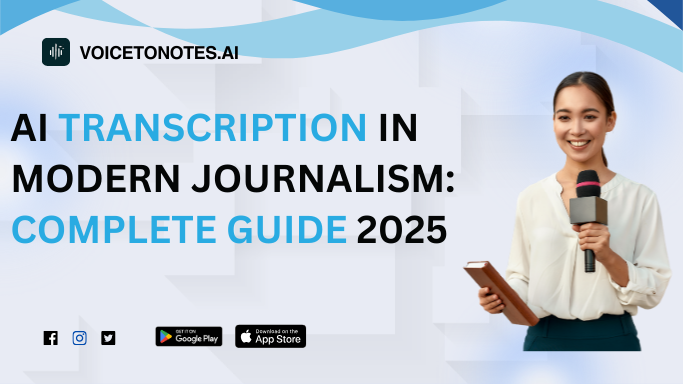
For decades, journalists have faced a universal challenge that consumed countless hours of their workweek: manually transcribing recorded interviews and audio content.
What once required painstakingly typing out every word, pause, and utterance from audio recordings—a process that could take four to six hours for every hour of content—has been fundamentally transformed by artificial intelligence transcription technology.
AI transcription represents one of the most practical and transformative technologies to emerge in modern newsrooms. This technology has evolved from a promising innovation to an indispensable tool that enables journalists to convert spoken words into searchable, editable text in minutes rather than hours, fundamentally changing how news professionals approach their craft.
The Old Workflow vs. The New Workflow
Before AI: Manual Transcription Challenges
Traditional transcription workflows presented significant barriers to efficient journalism. Reporters would spend hours manually typing out interview content, often working late into the evening to prepare transcripts for the next day's stories.
This manual process was not only time-consuming but expensive when outsourced to professional transcription services, with costs that many smaller newsrooms could ill afford.
Manual transcription also created accessibility challenges for audio content. Without searchable text, journalists had to rely on handwritten notes and memory to locate specific quotes or information within lengthy recordings.
This made cross-referencing information across multiple interviews or press conferences extremely difficult, often resulting in missed connections or overlooked story angles.
After AI: The Streamlined Digital Process
Modern AI transcription has revolutionized this workflow entirely. Journalists can now upload audio or video files and receive searchable transcripts within minutes, with industry-leading services achieving accuracy rates of 95% or higher under optimal conditions.
The technology can handle multiple speakers, identify different voices, and even process content in over 40-50 languages, depending on the platform.
This transformation has freed journalists from the tedious aspects of transcription work, allowing them to focus their time and energy on analysis, fact-checking, and crafting compelling narratives.
Real-time transcription capabilities mean that press conferences and live events can be immediately converted into searchable text, enabling rapid response to breaking news situations.
Key Applications of AI Transcription in Journalism
Interview Transcription
The most widespread application of AI transcription in journalism remains the conversion of recorded interviews into text format. This use case has become so fundamental that 79% of modern newsrooms report using some form of automated transcription for interview content.
Journalists can now conduct interviews knowing that accurate transcripts will be available immediately afterward, complete with timestamps and speaker identification.
The technology excels particularly in handling phone interviews, video calls, and field recordings where audio quality may be less than optimal. Advanced AI systems can filter background noise and enhance speech clarity, making previously difficult-to-transcribe content accessible.
Investigative Journalism
For investigative reporters, AI transcription has proven transformative in managing the dozens of interviews and hours of audio content typical of long-form journalism projects.
Having searchable transcripts of extensive source material allows journalists to identify patterns, cross-reference testimony, and uncover inconsistencies that might otherwise be missed in raw audio files.
The ability to search across multiple transcripts for specific keywords, phrases, or topics has revolutionized how investigative teams approach complex stories.
Reporters can now quickly locate and verify quotes, identify discrepancies between different sources, and build stronger, more fact-based narratives.
This capability has proven especially valuable when dealing with whistleblower testimonies, government accountability stories, and other sensitive investigations requiring meticulous documentation.
Broadcast Journalism
Television and radio news operations have integrated AI transcription into their production workflows for creating scripts, closed captions, and searchable archives.
Broadcasting organizations use the technology to generate real-time captions for live events, ensuring compliance with accessibility regulations while making content available to hearing-impaired audiences.
The technology also enables broadcasters to quickly create text-based content from video packages, allowing for rapid repurposing of broadcast material into digital articles and social media content.
Many news organizations report that AI transcription has significantly streamlined their multimedia content creation process.
Fact-Checking and Verification
AI transcription has enhanced fact-checking capabilities by providing instant access to searchable transcripts of speeches, press conferences, and interviews.
Fact-checkers can rapidly locate specific claims within lengthy audio or video content, enabling faster verification processes during live events or breaking news coverage.
The technology supports the creation of real-time fact-checking systems that can identify claims as they are made and cross-reference them against existing databases of verified information.
This capability has proven particularly valuable during political events, press conferences, and other high-stakes public communications where rapid fact verification is essential.
The Broader Impact on the Newsroom
Accelerated News Cycles
AI transcription has contributed to the acceleration of news cycles by dramatically reducing the time between newsgathering and publication.
Stories that previously required overnight transcription work can now be developed and published within hours of interviews being conducted.
This speed advantage has become crucial in an era where digital-first news organizations compete on the basis of timeliness and rapid response to breaking developments.
Enhanced Focus on Analysis and Storytelling
By automating the mechanical aspects of transcription, AI technology has allowed journalists to redirect their time and energy toward higher-value activities.
Rather than spending hours typing out interviews, reporters can focus on analysis, additional reporting, and crafting more compelling narratives.
This shift has led to deeper, more analytical journalism in many newsrooms that have successfully integrated the technology.
Increased Accessibility for Journalists
AI transcription has improved accessibility within newsrooms themselves, particularly for journalists with hearing impairments. Real-time transcription capabilities enable these professionals to participate more fully in press conferences, interviews, and newsroom meetings.
The technology has also made journalism more accessible to professionals working in noisy environments or situations where audio content is difficult to process manually.
Challenges and Ethical Considerations
Accuracy and Quality Control Issues
Despite significant advances, AI transcription systems still face accuracy challenges, particularly with poor audio quality, multiple speakers talking simultaneously, or technical jargon and specialized terminology.
Background noise, regional accents, and non-native speakers can reduce accuracy rates significantly, requiring human review and correction.
Industry experts emphasize that automated transcription should be viewed as a first draft rather than a final product, particularly for critical reporting where quote accuracy is paramount.
Many newsrooms have implemented quality control processes that combine AI efficiency with human oversight to ensure accuracy standards are maintained.
The Continued Need for Human Review
Professional journalism standards require that all quotes be verified for accuracy, making human review of AI-generated transcripts essential. Transcription errors in legal proceedings, medical contexts, or sensitive political reporting could have serious consequences, making editorial oversight crucial.
The most successful implementations of AI transcription in journalism combine the speed and efficiency of automated systems with human editors who review and refine the output before publication. This hybrid approach maintains journalistic integrity while capturing the efficiency benefits of AI technology.
Data Privacy and Security Concerns
The use of AI transcription services raises significant privacy concerns, particularly when handling sensitive interviews with confidential sources or dealing with off-the-record information.
Journalists must carefully evaluate transcription providers' data handling policies, storage practices, and confidentiality protections before processing sensitive material.
Many professional transcription services now offer enhanced security features, including end-to-end encryption, secure data storage, and compliance with privacy regulations such as GDPR and HIPAA.
However, journalists working with particularly sensitive sources may still prefer manual transcription or locally-processed AI tools that do not transmit data to external servers.
Conclusion
AI transcription has evolved from an experimental technology to an essential infrastructure component of modern journalism. The technology has fundamentally altered how newsrooms operate, enabling faster news cycles, more thorough investigative reporting, and enhanced accessibility across the journalism profession.
While challenges around accuracy, privacy, and the need for human oversight remain, AI transcription has proven its value as a productivity multiplier that allows journalists to focus on the distinctly human aspects of their profession: asking the right questions, uncovering important stories, and crafting compelling narratives that serve the public interest.
As newsrooms continue to adapt to digital transformation pressures, AI transcription stands as a clear example of how artificial intelligence can enhance rather than replace human journalism, providing tools that amplify the profession's core mission of informing democratic society.
The technology is no longer a novelty but has become foundational to how modern newsrooms gather, process, and distribute information in an increasingly fast-paced media environment.
As AI transcription technology continues to improve in accuracy and capability, its role in supporting quality journalism will likely expand, making it an indispensable tool for news professionals worldwide.
